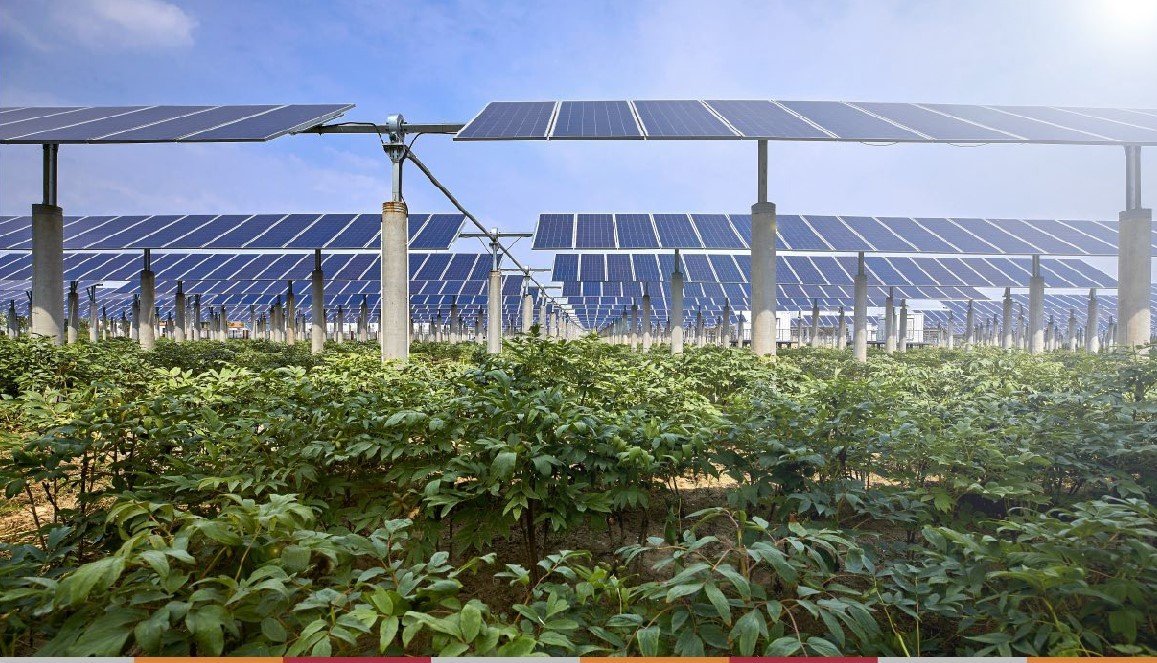2019 Renewables in Agriculture in California
About the Project

As California strives to meet its climate goals, it must adopt a new wave of renewable and sustainable energy technologies to reach the state’s energy demands and emissions standards. As renewables are becoming economically competitive, electrical grids are relying more heavily on these low-carbon generation resources. While a rapid development and expansion of renewables is transpiring, California, a state with deep roots in agriculture, must work to maximize the output its vast ranches and farmland, which are oftentimes prime locations for siting renewables. Agriculture exists not only as a crucial component of California’s history but as a thriving source of revenue and food security, with California being the most productive agricultural state in America.1 Thus, sustainable energy systems must be carefully integrated into existing agricultural land in order to generate renewable energy and supply farmers (this report’s all-encompassing term for agricultural operators) with an additional source of cash flow without cannibalizing valuable land. To aid in California’s transition, this report investigates the viability of co-locating emerging and established renewable energy technologies within agricultural operations.
The three energy sources focused on in this report are solar, wind, and biogas. Solar energy is an extremely viable technology given its low cost and California’s optimal solar conditions. However, the large land footprint of solar farms threatens agricultural land, so further research into novel solar co-locations is imperative. While wind energy co-locates well with agricultural and livestock operations due to its limited land footprint, many ideal wind conditions occur outside of ranch and farmland regions. Additionally, fugitive methane emissions from cow manure on Californian dairy farms can be collected and turned into biogas in biodigesters and refined into renewable natural gas (RNG). Californian dairy methane emissions will soon be regulated as requirements from Senate Bill 1383 are implemented, so harnessing biogas energy is not optional but will soon be mandatory.
Various incentive programs at the utility, state, and federal levels have proven to be powerful driving forces behind renewable energy commercialization efforts. Chief among these are the Renewable Fuel Standard, the Renewable Portfolio Standard, and various net metering and feed-in tariff programs. However, realizing the energy goals mandated by the legislature will require much more to be done. Further steps in actuating this transition could be as follows:
- The state of California has a number of successful programs that currently provide funding for a variety of renewable energy investments within the agricultural industry. Due to a large number of qualified applicants, these programs could be expanded to accommodate a broader range of energy technologies and farming operations, especially emerging energy systems that are seen by traditional financial institutions as less lucrative or stable investments. These grants could also be streamlined to ease the administrative burden on farmers and therefore encourage more to apply for them. Straightforward procedures in the application, approval, and implementation phases would reduce the obstacles to the development of successful projects.
- The Williamson Act protects farmland from urban sprawl and can inhibit the development of solar farms. While current limitations on developments under the Williamson Act are often necessary for the preservation of California’s best farmland, the definition should be adjusted to allow for certain renewable energy developments that complement or preserve farming operations through a co-located design.
- To further the development of solar without the loss of agricultural land requires continued investments in the R&D of innovative concepts regarding solar and agriculture co-location. This report identifies the following focus areas: the addition of crops under or between the panels that would allow farmers to continue crop production along with energy production; the planting of cover crops under or between panels that would allow for an additional grazing area for some livestock; the development of “movable” solar arrays which pair well with rotational agriculture; and continued development of solar panels that can capture sunlight on both their front and back (bifacial systems). Advancements in these technology areas could yield massive financial benefits to farmers despite heavy up-front costs.
- To maximize the benefits of the increased renewable energy production, additional financial assistance to acquire and further develop energy storage systems (i.e. batteries), microgrids, natural gas-powered vehicles, and other equipment electrification opportunities, will also be needed.
Through the TomKat Fellows' research, the team was able to provide Recommendations to public policy, utilities, and private industry on actions and changes that can be made with renewables in agriculture. The full findings of the TomKat Fellows' research can be found in their final report.
Renewables in Agriculture in California - Conclusions & Recommendations
General
1. Expand state agricultural grant programs
The state of California has several successful programs that currently provide funding to a variety of renewable energy investments within the agricultural industry. Programs such as SWEEP, REAP, and FARMER from the CDFA, CARB, and others have provided millions of dollars for investments in sustainable agriculture programs with both monetary and environmental benefits. However, most of these grant programs are oversubscribed with a large number of qualified applicants. Moreover, eligible projects of the majority of programs are required to be commercially available, which makes it difficult to receive funding for projects that seek to take advantage of emerging renewable energy technology. These programs should be expanded to accommodate both a higher quantity of qualified applicants and a broader range of energy technologies and operations, especially emerging energy systems that often fail to receive funding from financial institutions.
2. Streamline grant application process and implementation tracking
Funding programs for renewable energy technology investments in agricultural operations should be made as clear and simple as possible to avoid deterring agricultural operations from adopting them. Straightforward procedures in the application, approval, and implementation phases would limit the obstacles to the development of successful projects and thus increase the likelihood of more agricultural operations successfully applying for funding and implementing renewable energy technologies.
3. Align energy regulations and funding programs pertaining to agriculture
Regulations that seek to limit greenhouse gas emissions in the agricultural sector should be as closely aligned as possible with grant programs for renewable energy technology investments in agricultural operations. Aligning regulatory objectives with grant program requirements would make it easier for the agricultural sector to meet the ambitious regulatory requirements imposed on their industry, as well as derive benefits from renewable energy investments. In the case of biogas energy, collaborations between 68 agencies such as the California Energy Commission (CEC) and CDFA would help to ensure compatibility between grant programs, the methane abatement legislation, natural gas purity guidelines, and air quality concerns.
4. Expand solar/agriculture integration under the Williamson Act
Currently, the development of solar energy projects competes with farming operations for land since the same type of land is suitable for both activities. The Williamson Act protects productive farmland from urban development and thus inhibits the implementation of solar farms. However, solar and other renewable energy developments should be allowed when they are either designed for dual land use along with crops, pasture land, etc., or when that solar or wind resource directly contributes to the ongoing economic feasibility of a related farming activity (such as when solar arrays power irrigation, cooling, etc.). Distributed renewable energy systems will be key for agriculture to cope with more frequent disruptions, such as wildfires, to grid power supply, and tightening state regulations on greenhouse gas emissions, which may prove more detrimental to farmland preservation than renewable energy developments. While the Williamson Act is necessary for the preservation of California’s best farmland, the solar use easement should be adjusted to allow for and promote more renewable energy developments that complement or preserve farming operations.
5. Consider non-economic factors in converting land to renewables or dual-use opportunities
As farmers and policymakers weigh the conversion of farmland into solar arrays or wind farms, they should balance the positive externalities of farmland with the purely monetary benefits of investing in renewable energy development. For example, in many cases, the expected steady stream of income from solar developments may be greater than the variable income derived from existing farming. However, long-term food security and other positive externalities provided by the farmland must be taken into account so that renewable energy developments do not replace these externalities that are crucial to society as a whole. Therefore, if at all possible, farmland should be preserved along with the addition of solar or wind resources through dual-use setups that preserve farming while providing additional clean energy and associated benefits. These societal benefits should be recognized by the state and incentives provided to farmers to ensure they are not solely impacted by any net loses. 69
6. Offer more educational programs about the benefits and implementation of renewable energy in the agricultural sector
In order for the agricultural sector to learn about the benefits of investing in renewable energy technologies and how to implement them on agricultural land, California agencies should offer more educational programs with this very purpose. Officials on the state, county, and municipal levels should compile information, decree initiatives and host conferences to inform of the state’s rapidly changing energy landscape, the need for energy management on farms, and energy goals managed by the state, as well as suitable technologies to meet their energy demands and where to obtain the resources necessary to implement these technologies.
Solar
7. Support large-scale pilots of dual-use concepts
To further the development of solar without the loss of agricultural land requires support for the R&D of innovative concepts regarding solar and agriculture co-location that may yield massive financial benefits to farmers despite heavy up-front costs. For example, this could mean the addition of crops under or between the panels that would allow farmers to continue crop production along with energy production; the planting of cover crops under or between panels that would allow for an additional grazing area for some livestock; and the development of “movable” solar arrays which pair well with rotational land management.
8. Encourage R&D towards improvements in solar panel technology
Increased efficiency and reliability is key to reducing the levelized cost of solar energy and thus boost the attractiveness of solar energy investments. While levels of efficiency and reliability have come a long way, continued substantial R&D investments will be needed for solar to eventually outperform non-renewable sources of energy enough to cover the additional expenses for energy storage used to balance the intermittency of renewables with demand. R&D investments should also be focused on integrating bifacial systems within a variety of settings as such technology emerges. Bifacial systems projects would pioneer business practices and set bankability standards for new, often groundbreaking projects. 70
Wind
9. Expand siting locations for wind resources
Additional wind development has the power to significantly aid California in attaining its renewable energy goals. However, due to a recent federal DRECP decision, many of the optimal wind locations in southern California are currently barred from development due to the sentiments of environmental preservationists and those in the “Not in My Backyard” movement. Additionally, some have reservations towards wind due to its ability to kill nearby birds. In light of these restrictions, the California legislature must be open to additional sites for wind turbines in new parts of the state and on farms, and work with developers to create construction contracts which actively minimize and mitigate wind energy’s effects on the environment.
Biogas
10. Encourage new infrastructure and policies to facilitate the inclusion of biogas in natural gas and energy supplies
To make biogas usage more economically feasible in the agricultural sector, the state should institute offloading solutions for agricultural operations that would not otherwise have an economically viable or sustainable way to deliver their biogas to a pipeline. A policy that compensates farmers for converting biogas into electricity—either via eRINs or a feed-in tariff—would allow rural farmers to make better use of the biogas which they will soon be legally required to capture. This would have the added benefit of reducing diesel truck transportation, which is the most common method of transporting biogas to users, potentially reducing the amount of greenhouse gases released with the use of biogas energy.
Future Technologies
11. Include natural gas vehicles in California’s clean energy strategy
In addition to its aggressive vehicle electrification goals, the California legislature should also focus significant resources on converting heavy-duty diesel trucks to natural gas (and by extension RNG) fueled vehicles. The government should support companies laying the ground for lower carbon alternatives to diesel trucks which would reduce net 71 emissions of greenhouse gases and other pollutants; especially as the supply of renewable natural gas grows.
12. Support and expand R&D surrounding the electrification of agricultural equipment
Some steps have been taken to foster on-farm consumption of renewable energy, such as the replacement of diesel pumps with solar-powered alternatives. However, additional attention should be given to other electrification opportunities: vehicles such as tractors and other agricultural equipment with significant energy usage and emissions. Inducements for manufacturers to research and develop new electrical technologies that can be used to replace or retrofit traditional agricultural vehicles and equipment should be developed to increase the potential for on-site renewable energy use.
13. Promote further investment into the R&D of energy storage technology
Further investment into the R&D of energy storage technology is needed as such technology will be a key enabler to the proliferation and utilization of renewables in the future. One of the largest current roadblocks to renewable energy adoption today is the lack of cost-effective storage technology. In many cases, renewables are not being adopted because infrastructure is not in place to move energy the distance from the generation source to its end-user. However, with further storage technology, renewables could be developed alongside batteries that can manage energy dissipation. This would allow farmers to use generated energy when they need it and inject it into the grid during times when utilities are experiencing most demand. For example, since water pumping is one of the major uses of electricity in agricultural operations, the ability to pump and store water (pumped-storage hydropower) during times of high energy input or low electricity demand for later use, would provide unique energy storage and load shifting options that could benefit both the utility and the agricultural operation.
Renewables in Agriculture in California - Project Final Report

2019 Energy Impact Fellows
Lucy Brown

Lucy Brown is a rising sophomore studying mechanical engineering. She was raised in West Des Moines, Iowa; where she saw firsthand how agriculture impacted her community. She is passionate about exploring how we can improve technology to live more environmentally-conscious lives and how we can use policy to promote this goal. In particular, she likes to focus on how we can make transportation more efficient, improve public health, and conserve water. Aside from academics Lucy enjoys working as a peer counselor at the Bridge, participating in the Stanford Space Initiative, designing planes in the Stanford UAV club, watching documentaries, and reading. In the future, she plans to pursue a masters and use her skill set to help design sustainable energy systems and technology.
Ri Chen

Ri Chen is a rising senior pursuing a BS in Biomechanical Engineering. He was born in Kagawa, Japan and has spent the majority of his time in San Antonio, Texas and Houghton, Michigan. He has always been interested in working on sustainable projects that produce immediate and tangible impact. He hopes to use his newly acquired knowledge and skills from the TomKat Fellowship in his future endeavors in the intersection of engineering and medicine. Outside the classroom, Ri is a member of Stanford Ultimate, Stanford Jump Rope, and Cardinal Free Clinics. In his free time, you’ll catch him breaking ankles on the basketball court, slurping noodles, and in search of the best strawberry ice cream.
John Basil
John Basil is a rising junior studying Mathematics and Management Science and Engineering. He was born and raised on Kodiak Island, a remote archipelago off the Southern Coast of Alaska, where the tangible effects of climate change affect Kodiak's fishing and crabbing industries. John has a background in scientific research and economic policy and looks forward to applying his quantitative skillset to energy systems. Through his fellowship, John hopes to develop a technical, granular understanding of energy markets and research novel solutions to the environmental threats communities like Kodiak face.
Emily Elliott

Emily Elliott is a rising sophomore who is considering studying Native American Studies and Earth Systems with a focus on energy, science, and technology. She was born and raised in San Diego, California which is mainly where her passion for alternative energy comes from! Growing up in a state so conscious about the environment she has witnessed the use of solar, wind, and nuclear energy and engaged in various interesting classes which have set her on this track. Her passion for the environment originally comes from her indigenous background as a member of the Chinook Nation which resides along the Columbia river in Washington state. Since coming to Stanford she has been exploring Earth Systems classes in conjunction with Native Studies classes to gain a better understanding of their connection. With the experience she gains from Stanford and the TomKat Impact Fellowship she hopes to be able to bring her knowledge back to her people for the betterment of their life.
John Kohler

John Kohler is a rising sophomore from Medfield, Massachusetts interested in studying Economics or Management Science and Engineering who also holds a strong passion for humanities and the arts. As a student filmmaker who strongly considered attending film school, he brings a passion for storytelling and diligent organization to the project. His interest in renewable energy stems from a conference he attended in Costa Rica his freshman year of high school which focused on environmental sustainability, as well as his heightened interest in public policy since the 2016 election. When he is not studying he can usually be found in the "Band Shak," practicing drums for performances with the Leland Stanford Junior University Marching Band. At school, he continues to be involved with film, having recently released a music video for a fellow student musician. Although he is currently undeclared, he plans to use his long-standing interests in research and storytelling to help solve modern social problems.
Thea Rosenberg
Thea Rosenberg is a rising Junior pursuing a B.S. in Management Science & Engineering. Thea was born in Oslo, Norway, where she developed her love of the environment by spending time outdoors—be it skiing in the mountains, running in the forests, or swimming in the fjords. Growing up in an oil nation that is committed to changing course and tackling climate change, Thea has always been fascinated by sustainability and realized from an early age that she wants to pursue a career in this field. Thea is currently passionate about combining her coursework in management and engineering with her love for public policy to find effective solutions to our most pressing environmental problems—thus, she could not be more excited to join the 2019 cohort of TomKat Impact Fellows. Outside of her academics, Thea is actively involved in the Business Association of Stanford Entrepreneurial Students (BASES) and the International Undergraduate Community (IUC). Thea is also a Student Associate at the Stanford Technology Ventures Program (STVP) and a Course Assistant for MS&E 472: Entrepreneurial Thought Leaders' Seminar.

